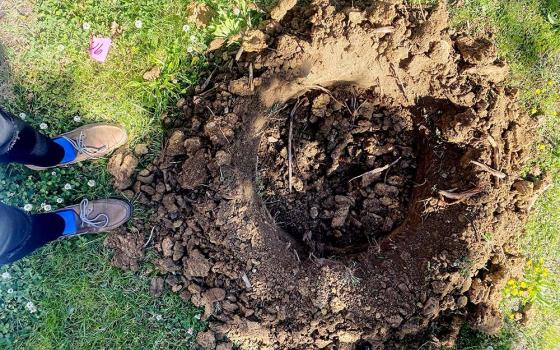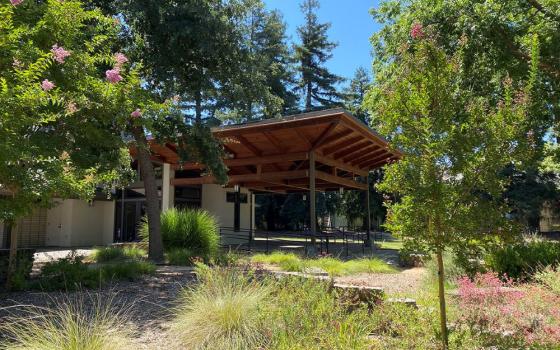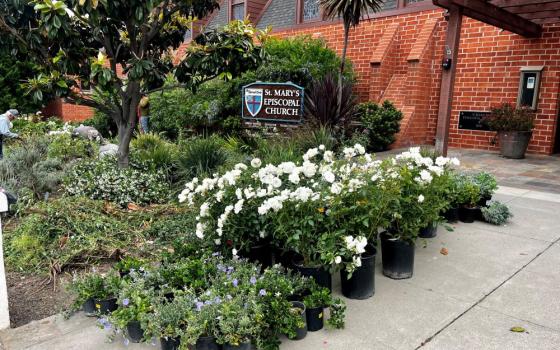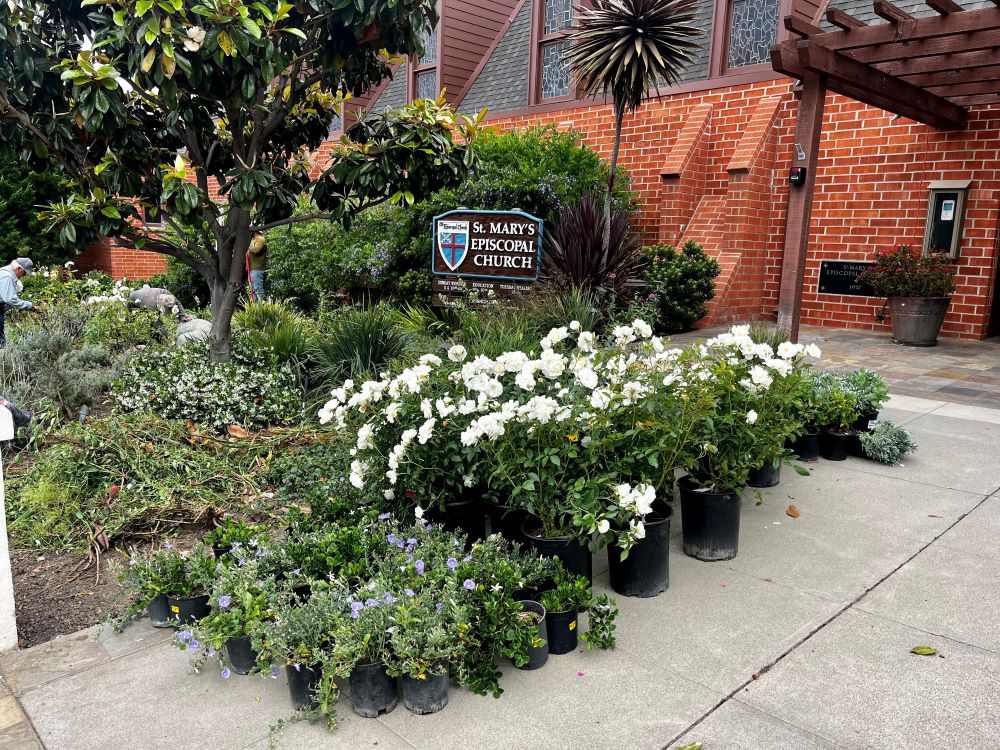
In the last century, Southern California has warmed by three degrees. The region is increasingly vulnerable to water scarcity, wildfires and coastal erosion. Small changes like those on St. Mary’s campus are an integral part of the wider Episcopal Church’s response to climate change. (Courtesy of St. Mary’s)
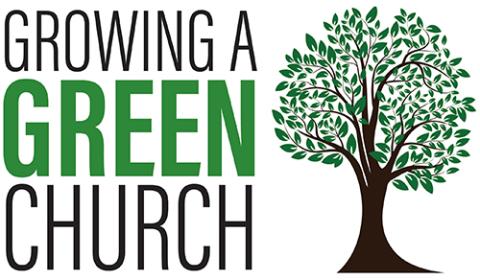
Editor's note: This story, originally published by Episcopal News Service, is part of "Growing a Green Church," an ongoing series focused on churches' efforts to steward their buildings and land effectively in the context of a changing climate. The project is produced in collaboration with The Christian Century, Episcopal News Service, Faithfully Magazine, National Catholic Reporter and Sojourners, with support from the Solutions Journalism Network and funding from the Fetzer Institute. Find more stories in the series here.
Over the past two years, St. Mary's Episcopal Church, which sits on a hill four blocks away from the Pacific Ocean in Laguna Beach, California, has overhauled its property, adding drought-resistant native plants to its gardens and installing a drip irrigation system to avoid water runoff.
The Episcopal Church seeks to connect Episcopalians and others around gardening and growing food through its Good News Gardens movement.
"Our natives live naturally in very dry conditions all of the time, getting only water and rain in the winter months (sometimes), and so they have evolved to live in low-water conditions," Martha Simkins Davis, a parishioner and Orange County-certified master gardener who spearheaded the overhaul of the church's gardens, told Episcopal News Service. "[And] they are drought tolerant and drought resistant."
Southern California is one of five Mediterranean climate zones — characterized by warm dry summers and rainy winters — in the world. Drought conditions are common across the state, where in 2021 all 58 counties were under drought emergencies. While California currently is not experiencing extreme drought, climate change puts the state at increasing risk for abnormally dry periods in the future.
In the last century, Southern California has warmed by three degrees. The region is increasingly vulnerable to water scarcity, wildfires and coastal erosion. Sea level is expected to rise by 1 to 4 feet in the next century, putting coastal ecosystems and communities at risk.
Advertisement
One way to adapt to climate change and to mitigate its impacts is to return to landscaping with native species rather than grass or other non-native plants. In addition, financial incentives exist to help. Government water conservation programs often encourage native vegetation over grass, since the latter requires a lot of water. Orange County, where Laguna Beach is located 50 miles south of Los Angeles, offers rebates starting at $3 per square foot of turf grass removed, which can lessen water usage by 50-70%.
St. Mary's took advantage of the county program, and what was once a lawn filled with parishioners' unwanted plants and where neighbors let their dogs romp became a haven of water-wise, useful flora, surrounded by moisture-retaining mulch.
In the church's front garden, thyme, which requires much less water than grass, acts as ground cover, and volunteer gardeners also planted lavender, sage and rosemary. All the plants in the front of the church are hues of blue and white, the colors of St. Mary. Davis is currently the sole parishioner designing and monitoring the gardens, along with local gardener and friend of St. Mary's, Sylvia Briseño.
The church also installed a drip irrigation system that waters plants at their roots to avoid runoff and evaporation associated with sprinklers.
Laguna Beach receives on average 12 inches of rainfall a year, and the region's native plants have smaller leaves compared with tropical plants as well as other evolved characteristics that allow them to survive in dry conditions near an ocean.
A monarch butterfly caterpillar perched on milkweed in St. Mary’s Episcopal Church's garden. Planting the right kind of milkweed is of utmost importance. (Martha Simkins Davis)
"Native plants here go dormant in the summer months, as opposed to plants that go dormant in winter in many places," Davis said. "In fact, a lot of natives can't take summer water, or they will die."
Finding the appropriate plants can be a challenge when overhauling a landscape to reflect natural biodiversity due to climatic specificities. In Southern California, proximity to the ocean, salty air and alkaline soil must be considered for a plant's well-being. While planning a pollinator garden to attract bees, butterflies and hummingbirds, Davis said they had to be specifically wary about milkweed.
"Most people have a milkweed that, here in Southern California, is foreign and blooms year-round," she said. "It actually deters the migration of the monarchs [butterflies] because they stick around and hang out on these plants year-round, and they're not supposed to do that. So the California Native Plant Society and [others] have been encouraging people to plant the native milkweed."
The pollinator garden, complete with brightly blooming nectar plants to attract hummingbirds, grows among the ruins of St. Mary's original building, demolished in the 1970s because of structural instability and earthquake risks. Now, Davis said, the ruins are still a place where one can find spiritual respite.
"I'm of the theology that God is in everything, and I think in order to be in the present moment, we have to be in our senses, too," Davis said. "To be in nature and then to be able to smell and touch and taste and even use [it] in your food, it's really a beautiful thing. To me, it's kind of what churches should be about, it's finding that sustenance and calm and peace."
The landscaping changes have helped the parish not only limit its water usage but reintegrate with the natural landscape, and they also led to a greater connection with the community — Laguna Beach has received a most water-wise city award eight years in a row.
"The renovation of our gardens has undoubtedly deepened the connection between our congregation and broader initiatives to raise climate awareness and resilience," the Rev. Lester Mackenzie, St. Mary's rector, told Episcopal News Service. "They offer a tangible demonstration of how individual actions can contribute to extensive environmental efforts."
St. Mary's Episcopal Church is four blocks from the Pacific Ocean in downtown Laguna Beach, California. In 2022, the gardens transitioned to all native California plants. (Martha Simkins Davis)
Small changes like those on St. Mary's campus are an integral part of the wider Episcopal Church's response to climate change, the Rev. Melissa McCarthy, canon to the ordinary in the Diocese of Los Angeles, which includes Orange County, told Episcopal News Service.
"They're using their space and making it more beautiful," McCarthy said. "I mean, that in and of itself is enough, but they're doing it in a way that's sustainable and actually helpful to the world. It kind of makes me cry."
McCarthy also is the chair of the Bishop's Commission on Climate Change. The commission has been active for just over a year, but some of their activities so far include the creation of an assets-based network of churches that can materially support each other in the case of natural disasters, as well as educational programs to help congregations understand the impacts of climate change.
McCarthy said her personal motivation for serving on this commission is partially experiential. Just after becoming canon to the ordinary, fires ripped through the area near the church she used to serve in Oak Park, northwest of Los Angeles. Shortly after, a mudslide came through, killing 23 people.
"People were just coming in in the middle of the night, having lost their homes and not knowing where to go and they showed up at the church," McCarthy said. "What that told me is we really need to be equipping our churches to manage when these kinds of situations hit our communities, and it's going to continue."
St. Mary's Episcopal Church in Laguna Beach, California, installed a drip irrigation system and began planting native plants in 2014. In 2022, the gardens transitioned to all native California plants. (Martha Simkins Davis)
Climate change and associated natural disasters will continue to put California communities at risk. While institutional work is necessary, McCarthy said local adaptations like those at St. Mary's provide tangible mitigation solutions.
"I think every church that does something like this is really teaching their community what's possible," McCarthy said. "And the more we learn what's possible, the more likely we are to make our way through this crisis."
Planting native species in their gardens is just one project that aligns with the broader shift toward environmental awareness at St. Mary's. Through involvement with the Laguna Beach Interfaith Council, parishioners have participated in beach cleanups and trail maintenance as part of the Love Laguna Initiative. They are also looking to adopt a local watershed as part of their commitment to care for creation.
"It is always a wonderful invitation to those in the neighborhood, that here we are going to explore not only our biological connection to all things that [are] within creation, but how does that blossom in the container of religion," said Mackenzie, who grew up by the ocean in South Africa and who served on the churchwide Task Force for Creation Care and Environmental Racism.
Davis was concerned about how their neighborhood would receive the new gardens, since the grounds, particularly the lawn, have always been a community gathering place.
However, the improved gardens have proven worthwhile. The environmental benefits are numerous, from water conservation to pollinator protection, and, it turns out, so are the social ones. Davis said there's been an increase in wedding ceremonies on church grounds, and Mackenzie has noticed neighbors stopping on their walk to join outdoor services, concerts and events.
"There's nothing quite like a brilliant sunset from our gardens on a summer evening to leave people in awe of the Divine Creator Spirit," Mackenzie said.
Lynette Wilson, Episcopal News Service managing editor, contributed to this story.



